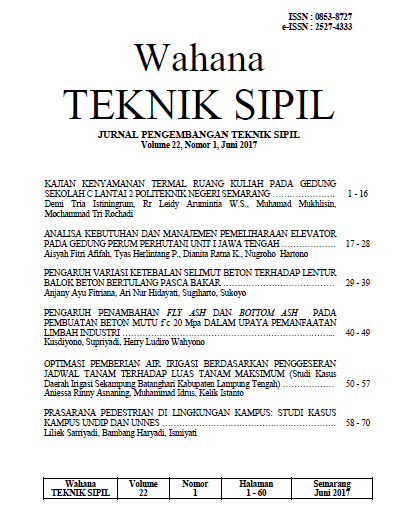Kajian Kenyamanan Termal Ruang Kuliah Pada Gedung Sekolah C Lantai 2 Politeknik Negeri Semarang
DOI:
https://doi.org/10.32497/wahanats.v22i1.895Abstract
In carrying out the activity, people are generally want a comfortable condition. One of the physical environmental factors that affect the level of comfort when working is thermal comfort. Thermal comfort is the feeling that someone is comfortable with
the condition of the environment temperature, which is described as a condition where a person does not feel too hot or too cold in specific environments. Things that influence the thermal comfort is air temperature, humidity, wind speed, insulant clothing value and rate of metabolic. The study was conducted in lecture room State Polytechnic of Semarang, 4 rooms on the 2nd floor have been selected as the object in this study because those rooms are located at the east and the west of building and still using natural ventilation, those rooms are SC II-01, SC II-02, SC II-09 and SC II-10. This study was conducted to determine how the level of thermal comfort in the classroom. The method used in this research is PMV (Predicted Mean Vote) and PPD (Predicted Percentage of Dissatisfied). PMV is used to determine the comfort level of student as users of the room, while the PPD is used to determine the level of student dissatisfaction as users of the room. From the results obtained in mind that the three classes in he category of heat that is SC II-01, SC II-02 and SC II-09. While another class, namely SC II-10 into the warm category.
Kata kunci : PMV, PPD, Thermal Comfort, Lecture Room, Classroom
Downloads
Published
Issue
Section
License
Authors who publish with this journal agree to the following terms:Authors retain copyright and grant the journal right of first publication with the work simultaneously licensed under a Creative Commons Attribution License that allows others to share the work with an acknowledgement of the work's authorship and initial publication in this journal.
Authors are able to enter into separate, additional contractual arrangements for the non-exclusive distribution of the journal's published version of the work (e.g., post it to an institutional repository or publish it in a book), with an acknowledgement of its initial publication in this journal.
Authors are permitted and encouraged to post their work online (e.g., in institutional repositories or on their website) prior to and during the submission process, as it can lead to productive exchanges, as well as earlier and greater citation of published work (See The Effect of Open Access).






